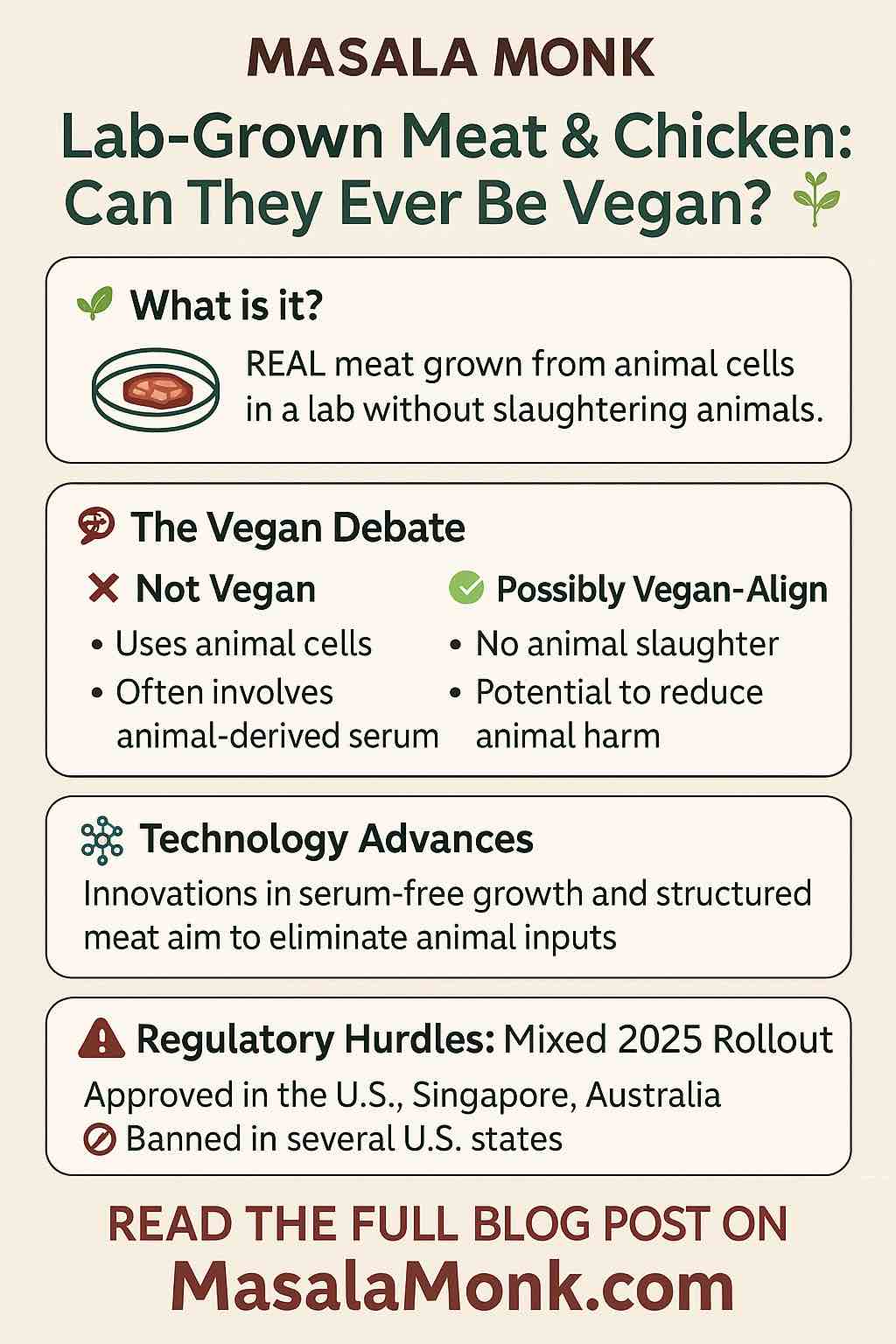
Imagine biting into a tender chicken nugget or sizzling steak—without ever harming an animal. That’s not science fiction anymore.
Welcome to the world of lab-grown meat—also known as cultured, cell-based, or cultivated meat. Grown in bioreactors from animal cells, this cutting-edge innovation promises to revolutionize food, reduce carbon footprints, and eliminate animal slaughter. But it also raises a heated ethical question:
Is lab-grown meat actually vegan?
In this blog post, we’ll explore:
- What lab-grown meat really is and how it’s made
- Why it excites scientists, startups, and some vegans
- Where the Vegan Society and other purists stand
- Where the industry is headed—and what would make it truly “vegan”
🔬 What Exactly Is Lab-Grown Meat?
Lab-grown meat is real animal flesh, just not sourced from a slaughtered body. Here’s how it works:
🧫 The 5-Step Process:
- Cell Collection – A biopsy is taken from a live animal.
- Cell Cultivation – Cells are fed in nutrient-rich “growth media” to multiply.
- Scaffold Building – Cells attach to a structure to form texture.
- Maturation in Bioreactors – The cells grow into muscle fibers.
- Harvest & Processing – The tissue is shaped into products like nuggets or burgers.
Products already approved:
- Chicken from GOOD Meat and UPSIDE Foods (USA & Singapore)
- Quail from Vow (Australia)
- Salmon from Wildtype (awaiting US clearance)
- Foie gras from Gourmey (Europe, pending distribution)
🧠 The Big Question: Is It Vegan?
Let’s get to the philosophical heart of the matter.
🟥 The Case Against: Not Vegan
According to the Vegan Society and other ethical purists, lab-grown meat is not vegan. Here’s why:
| Reason | Explanation |
|---|---|
| 🐄 Animal Cells | Even though the animal isn’t killed, the product starts with a biopsy—thus still exploiting animals. |
| 🩸 Fetal Bovine Serum (FBS) | Many cell cultures still rely on FBS—extracted from calf fetuses. A major ethical red flag. |
| 🧪 Corporate Co-option | Cultivated meat is often backed by meat industry giants, raising concerns about greenwashing. |
| 🧠 Speciesism | Critics argue it still normalizes the use of animals for food, even in a sanitized form. |
From this angle, lab-grown meat might reduce cruelty but doesn’t eliminate exploitation.
🟩 The Case For: Possibly Vegan-Aligned
Others—particularly utilitarian vegans—argue lab-grown meat is a massive step forward.
| Argument | Benefit |
|---|---|
| 💀 No Slaughter | No animals are killed. That alone could save billions of lives annually. |
| 🌍 Environmentally Sustainable | Cultured meat can cut land, water, and emissions by up to 96%. |
| 👥 Ethical Bridge for Omnivores | It could convert meat-lovers without asking them to change taste habits. |
| ⚙️ Improving Tech | The industry is moving toward serum-free, animal-free processes. If those succeed, the ethical objections could disappear. |
As one Reddit user put it:
“If it harms no animals and saves millions, what’s more vegan than that?”
🌍 The Current Landscape (As of Mid‑2025)
Let’s map where lab-grown meat stands today—technologically, politically, and ethically.
🧪 Tech Advances
- Serum-Free Growth: Companies like Mosa Meat and Bene Meat are pioneering serum-free media—crucial for vegan alignment.
- Structured Meat: Japan’s researchers have built circulatory systems into lab-grown cuts, allowing steak-style textures.
- AI Optimization: “Digital twins” model ideal growth pathways—already in use by Gourmey (France) and Mirai Foods (Switzerland).
🏛️ Regulations & Approvals
- ✅ Approved in: Singapore, USA, Australia, Israel
- ⛔ Banned or restricted in 10 U.S. states: Florida, Nebraska, Iowa, etc.
- 🐾 In pet food: UK startup Meatly launched cultured chicken for pets (Feb 2025).
🌱 Vegan Labels, Ethics & Community Sentiment
🟡 Emerging Certifications
- C‑Label (Switzerland) – Tracks sustainability and cruelty metrics.
- Halal-certified lab meat – In development by Korean firm Simple Planet (serum-free).
💬 Vegan Community Views
| Group | View |
|---|---|
| Vegan Society | Strong NO—animal involvement and FBS use are incompatible with veganism. |
| Pragmatist Vegans | YES (conditionally)—if animal harm is eliminated or minimized, it aligns with vegan goals. |
| Plant-Based Traditionalists | Prefer plant proteins like tempeh, seitan, and mycoprotein (Quorn), which are inherently vegan. |
Online forums (e.g. Reddit’s r/vegan) are split but trending toward “ethical pragmatism”—supporting lab meat if it helps animals.
🔮 The Future: Could It Ever Be Vegan?
Yes—conditionally. Here’s what needs to happen:
✅ Checklist for Vegan Alignment
- 🧫 No animal biopsies – Use immortalized cell lines or synthetic biology.
- 🩸 No animal-derived serum – Switch to fully synthetic or plant-based media.
- 🧪 Transparent ethics – Remove ties to factory farming; seek cruelty-free certifications.
- 🌱 Clear labeling – Avoid misleading terms; empower consumer choice.
If the industry meets these goals, future lab-grown meat could potentially earn a “cruelty-free” or even “vegan-certified” badge.
🥗 So, What Should You Do Today?
Here’s a practical decision tree for the ethically conscious eater:
Do you identify as a strict ethical vegan?
→ ❌ Skip lab-grown meat for now.
Are you plant-based for sustainability or animal welfare?
→ ⚠️ Consider supporting the transition.
Are you a meat eater trying to reduce animal harm?
→ ✅ Lab-grown meat is a great next step.
In short: Your decision depends on your ethical framework. For some, lab-grown meat is a compromise. For others, it’s a bridge to a more humane food system.
💡 Final Thoughts: Progress, Not Perfection
Lab-grown meat isn’t perfect. It still has hurdles—technical, ethical, and political. But it may be one of the most powerful tools we have to reduce animal suffering on a global scale.
It’s not about being purist. It’s about being practical.
Whether you’re vegan, vegetarian, flexitarian, or omnivore—the choices we make today shape the food system of tomorrow.
🌱 Your Turn:
- Would you eat lab-grown meat?
- Does it align with your values?
- What changes would you need to see to consider it “vegan enough”?
Let us know in the comments. Let’s spark a thoughtful, respectful discussion. 💬
📚 10 FAQs on Lab-Grown Meat & Veganism
1. What exactly is lab-grown (cultivated) meat?
Lab-grown meat is real animal meat grown from cells in a lab—without raising or slaughtering animals. It uses animal cells placed in nutrient media to grow muscle tissue in bioreactors, mimicking conventional meat in taste and texture.
2. Is lab-grown meat currently vegan?
No. Most cultivated meat still uses animal-derived inputs such as fetal bovine serum (FBS) and originates from animal biopsies. This violates core vegan principles, which oppose all forms of animal exploitation.
3. Why do some vegans support lab-grown meat?
Utilitarian or pragmatic vegans support it because it can drastically reduce animal suffering, slaughter, and environmental harm—viewing it as a transition technology even if it’s not technically vegan.
4. What does the Vegan Society say about it?
The Vegan Society officially states that lab-grown meat is not vegan, primarily due to its origin in animal cells and the continued use of animal-derived growth media.
5. Are companies working on vegan-compatible lab-grown meat?
Yes. Companies like Mosa Meat, Upside Foods, and Bene Meat Technologies are developing serum-free, animal-free growth media. If successful, these products may align more closely with vegan ethics in the future.
6. Is there any cultured meat product certified as vegan?
No. As of mid-2025, no lab-grown meat has received a vegan certification. However, new labeling systems like Switzerland’s “C-Label” and efforts to certify serum-free products are in progress.
7. Can I eat lab-grown meat if I’m plant-based for environmental reasons?
Yes, many environmentally motivated consumers choose lab-grown meat for its lower carbon footprint, land use, and water consumption—even if it’s not vegan by strict ethical standards.
8. What’s the difference between lab-grown meat and plant-based meat?
Plant-based meats (e.g., Beyond, Impossible) are made entirely from plants and are vegan. Lab-grown meat is real meat made from animal cells and is not currently vegan, though it avoids slaughter.
9. When will lab-grown meat become truly vegan?
That depends on the development and commercialization of:
- Animal-free cell lines
- Serum-free, synthetic or plant-based growth media
- Full decoupling from animal inputs
If achieved, vegan certifications could follow within a few years.
10. Is lab-grown meat safe to eat?
Yes. Regulatory bodies in the U.S., Singapore, Australia, and Israel have approved certain lab-grown meat products after rigorous safety reviews. Serum-free products are also being evaluated for food safety.










